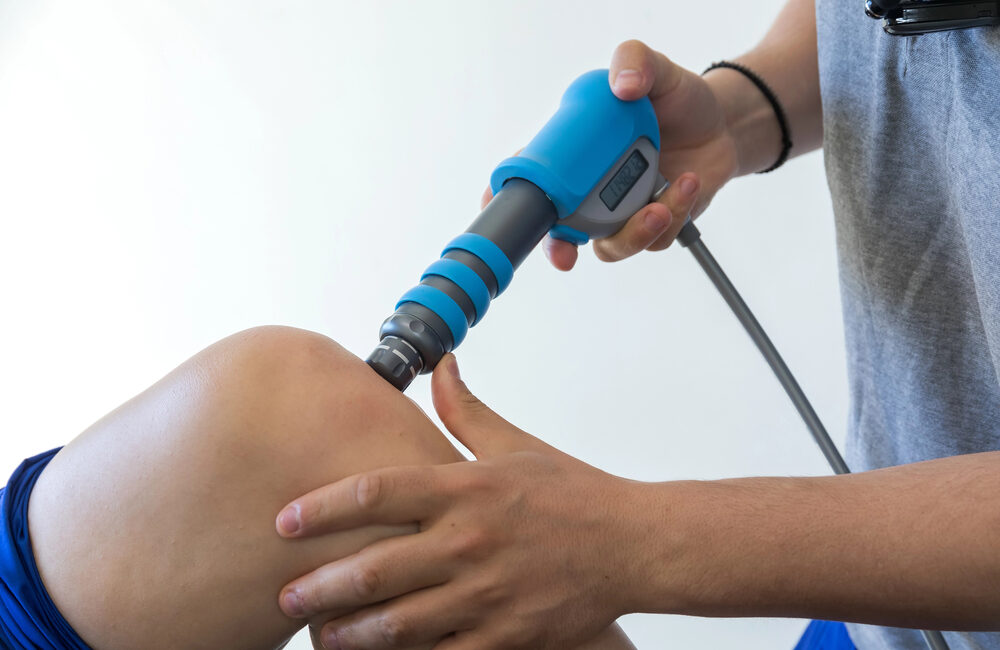Shockwave therapy: what it is and how it can help

Have you seen a new machine making it’s way around our clinic? We’ve been very tardy communicating our new addition to the clinic, but better late than never!
Shockwave has arrived! Sounds spaceage and cutting edge doesn’t it? Well if you know Pete and I well, you know we don’t jump into shiny, new things without a healthy dose of skepticism. We’re not what you might call early technology adopters. Highly unlikely you’ll find us part of the early wave of Neurolink implant patients!
Shockwave in health care has actually been around for decades, reported as early as the 80’s and 90’s in scientific literature. However the specific utility for use in physiotherapy clinics like ours has been mounting more rapidly in the last decade or two.
So it’s been on our wish list for a while, and we’re proud to say…it’s finally here!
Since we’ve been fielding a lot of questions about Shockwave therapy, we figured we better set things straight: what it is, how it can help and what specific conditions it can help.
For those of you who want to see the unit in operation, check out this video.
What is shockwave therapy?
A shockwave is an intense, but very short, acoustic pressure wave that is created when a projectile inside the handheld applicator impacts against an immovable surface, the pulse transmitter. The kinetic energy at impact is converted into sound energy, the acoustic pulse.
To see what’s happening inside the handheld applicator check out this video https://www.youtube.com/watch?v=PlwIg2gnils
The acoustic pressure wave then transmits radially inside the patient’s body causing mechanical stimulation to cells it comes in contact with.
These pulses are applied to the affected area for short periods of time, usually 5 minutes or less.
How does shockwave help?
The purpose of this treatment is to cause disruption to tissue that has not been able to heal itself. Essentially shockwave re-ignites our bodies own healing process.
Shockwave generally would not be considered for an injury that just happened, as the tissue is already undergoing a natural healing process.
The early application for shockwave therapy within musculoskeletal injuries was found in cases of poorly healed bone injuries and repetitive strain/chronic tissue overload issues such as tendinopathies or plantar fasciitis.
Although the precise mechanisms are still an ongoing research topic the prevailing thought is that the mechanical and cellular effects of these acoustic pressure waves lead to improved tissue healing and altered pain signalling.
Some of the more specific effects being tested include decreased substance P, selective loss of unmyelinated nerve fibres, decreased expression of calcitonin-related peptide in dorsal root ganglia, activation of the serotonergic system, proliferation of tenocytes, elimination of damaged matrix constituents, microdisruption of poorly vascularized tissue, increased neovascularization, enhanced collagen synthesis, antifibrosis and osteoblast growth and proliferation.
What conditions can shockwave therapy help?
The strongest support for shockwave is for poorly healed soft tissue conditions, such as tendinopathies and plantar fasciitis.
Specifically, shockwave has been shown to be effective in the treatment of
- calcific tendonopathy of the shoulder or hip
- rotator cuff tendinopathy
- lateral elbow epicondlyopathy
- greater trochanteric pain syndrome
- hamstring tendinopathy
- patellar tendinopathy
- Achilles tendinopathy
- plantar fasciitis/fasciopathy
- Frozen shoulder (adhesive capsulitis)
Shockwave has also been shown to be effective for poorly healed bone fractures and bone stress injuries such as medial tibial stress syndrome. Typically use of shockwave for treatment of bony injuries will provided with the supervision and guidance of a physician.
Shockwave can also effectively treat chronic myofascial dysfunctions such as trigger points. Soft tissue therapy such as massage therapy or active release would generally be the preferred starting point, however if non-responsive shockwave may be a great option.
There is some lower level evidence for the use of shockwave in the treatment of osteoarthritis, low back pain and carpal tunnel syndrome. Although these are highly intriguing applications of the technology, further evidence is needed to improve confidence in the outcome for these conditions.
Who should not get shockwave treatment?
Shockwave treatment should not be provided for patients with poorly controlled coagulopathies (ie. blood thinners), acute infection, pregnancy, direct application on growth plates, oncological tissue in the area to be treated, tumor metastases, multiple myeloma, lymphoma and in cases of complete tendon rupture.
What can I expect from my shockwave treatment?
Typically shockwave will be recommended as a standalone treatment. This is because shockwave treatment has been shown to have a greater analgesic effect for some conditions when applied as monotherapy versus when applied in conjunction with other interventions.
Treatment sessions will typically be a week apart and most conditions require 3-5 treatment sessions total. There are some conditions and circumstances where as many as 8-10 treatment sessions may be required.
Each treatment session will be approximately 5 minutes of direct contact with the handheld pusle applicator.
Shockwave can be uncomfortable for some patients. However research has shown that this sensory biofeedback is a necessary part of the treatment process. When shockwave treatment is applied under local anesthesia the treatment has been shown to be less effective.
When should I expect improvement in my condition?
Clinical improvement from shock wave therapy has been reported to start to occur within 3–12 weeks after treatment. It is completely normal to not notice a change in your symptoms after the first couple treatments.
Still have questions about shockwave? Please feel free to reach out, we would be happy to help.
